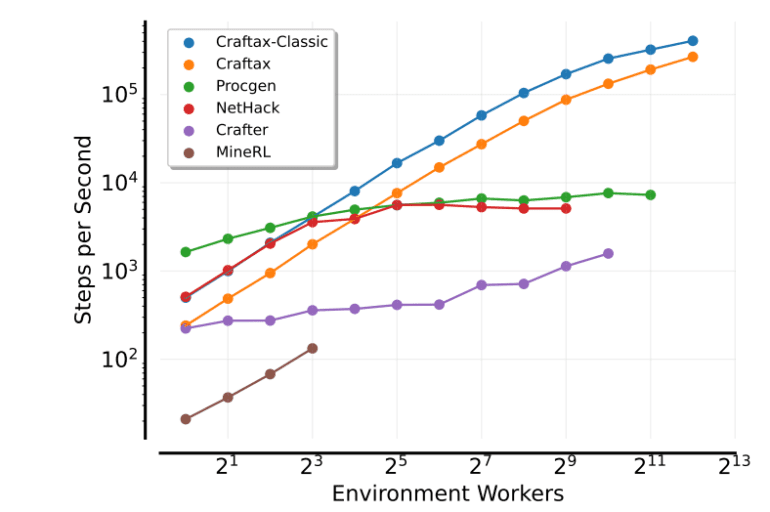- University of Oxford and University College London introduce Craftax, a groundbreaking machine learning benchmark for open-ended reinforcement learning.
- Craftax leverages JAX for enhanced speed and intricate dynamics, outperforming existing benchmarks by orders of magnitude.
- Craftax-Classic, a reimplementation of Crafter in JAX, demonstrates significant performance gains, achieving a 250% improvement over its Python counterpart.
- Basic PPO agents can solve Craftax-Classic to 90% of maximum return in just 51 minutes, with access to more timesteps, showcasing its potential for rapid experimentation.
- Craftax offers a more challenging setting inspired by NetHack and Roguelike games, featuring novel game mechanics and both symbolic and pixel-based observations.
- Results reveal shortcomings in current RL approaches when applied to Craftax, emphasizing the benchmark’s potential to stimulate innovation despite limited computational resources.
- Craftax-Classic serves as a smooth entry point for enthusiasts familiar with Crafter, indicating the benchmark’s adaptability and appeal across diverse user bases.
Main AI News:
In the realm of Reinforcement Learning (RL) algorithms, the significance of suitable benchmarks cannot be overstated. Just as the Arcade Learning Environment serves the realm of value-based deep RL algorithms and Mujoco caters to continuous control, benchmarks like the StarCraft Multi-Agent Challenge have addressed the domain of multi-agent RL. However, the landscape is evolving towards more open-ended dynamics encompassing procedural world generation, skill acquisition and reuse, long-term dependencies, and continuous learning, prompting the emergence of tools like MiniHack, Crafter, MALMO, and The NetHack Learning Environment.
Yet, despite their promise, these tools have been hindered by lengthy runtimes, rendering them impractical for current methodologies that lack extensive computational resources. Enter JAX, witnessing a surge in RL environments due to its ability to expedite end-to-end compiled RL pipelines. Thanks to efficient parallelization, compilation techniques, and the reduction of CPU-GPU transfers, experiments that once demanded days on compute clusters can now be completed within minutes on a single GPU.
In a bid to bridge these disparate worlds, a recent collaboration between the University of Oxford and University College London introduces the Craftax benchmark. Leveraging JAX as its foundation, Craftax operates at speeds orders of magnitude faster than its counterparts while embodying intricate, open-ended dynamics. Notably, Craftax-Classic, a JAX reimplementation of Crafter, surpasses its Python predecessor by an impressive 250%.
Remarkably, the researchers showcase that a basic Proximal Policy Optimization (PPO) agent can conquer Craftax-Classic, achieving a 90% maximum return in just 51 minutes, with access to significantly more timesteps. In response to the growing demand for greater challenges, they unveil Craftax, a more rigorous setting inspired by NetHack and the broader Roguelike genre. Craftax introduces an array of novel game mechanics, incorporating both symbolic and pixel-based observations to enrich the learning landscape. Interestingly, the symbolic variant operates approximately ten times faster than its pixel-based counterpart.
However, the results from their experiments shed light on the inadequacy of current approaches when applied to Craftax, underscoring the benchmark’s potential to drive innovation within RL research, even under constrained computational resources. The team envisions Craftax-Classic as a gateway, offering a seamless transition for enthusiasts acquainted with the Crafter standard. As the pursuit of more adaptable and challenging RL environments continues, Craftax emerges as a beacon, guiding the trajectory of future research endeavors.
Conclusion:
The introduction of Craftax marks a significant leap forward in the realm of machine learning benchmarks for reinforcement learning. Its enhanced speed, intricate dynamics, and adaptability open new avenues for research and experimentation. Craftax’s ability to expose shortcomings in current approaches underscores its potential to drive innovation within the market, encouraging the development of more robust RL algorithms and methodologies. As the demand for adaptable and challenging RL environments continues to grow, Craftax stands poised to redefine the landscape, shaping the trajectory of future research endeavors and market dynamics.

